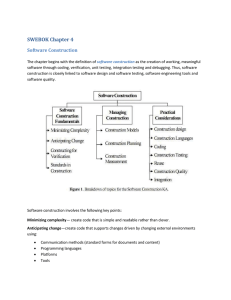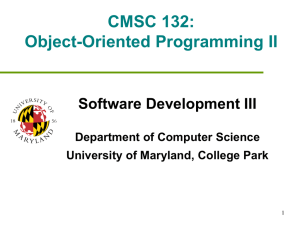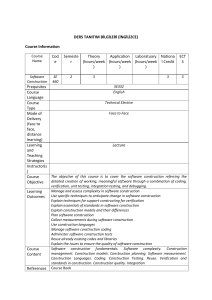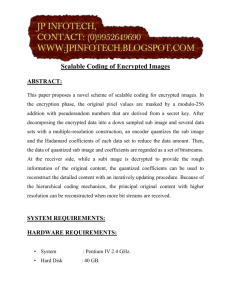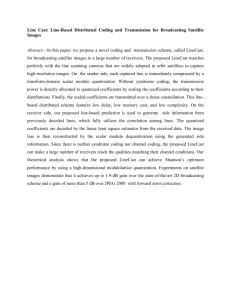Software Construction
advertisement
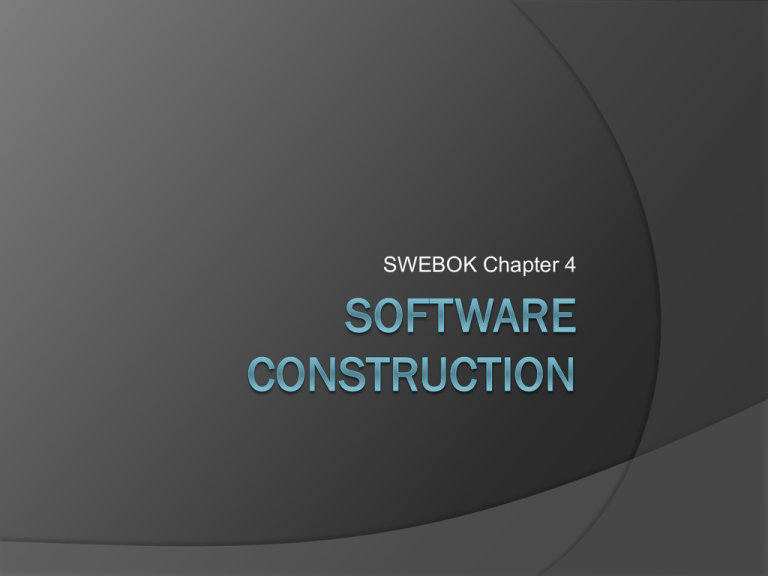
SWEBOK Chapter 4 Fundamentals Minimizing Complexity Anticipating Change Construction for Verification Standards in Construction Minimizing Complexity One of the strongest drivers in software construction Required due to human limitations of memory Minimizing Complexity How is complexity minimized during software construction? Use of standards Coding practices Construction-oriented quality techniques Creation of code that is simple and readable rather than clever Anticipate Change Software will change Coding techniques can be used to make change easier (designing for change is also critical) Construction for Verification Built is such a way to allow easy identification of defects By developers during construction By testers Construction for Verification Techniques Following coding standards Unit testing Organizing code to support automated testing Restricted use of complex/hard-tounderstand language structures Standards in Construction Communication methods Programming languages Platforms Tools External standards Internal standards Managing Construction Construction Models Construction Planning Construction Measurement Construction Models Linear construction view Construction only after significant pre- requisite work is complete Coding is main focus of construction Interative Construction occurs at the same time as other development activities Combination of activities all considered construction Construction Planning How are we going to build it? Affects prerequisite activities Extent to which they are performed Order in which they are performed Degree to which they are expected to be complete before construction begins Affects project’s ability to minimize complexity, anticipate change, and construct for verification Defines the order in which components are created and integrated, QA management process, allocation of task assignments, etc. Construction Measurement What aspects are being measured? Code developed (LOC) Code reused Code modified Code complexity Code inspection statistics Defects found Defects fixed Effort Scheduling Story points (velocity) Why do we need to measure construction? Practical Considerations Construction Design Construction Languages Coding Construction Testing Reuse Construction Quality Integration Construction Design Design done before construction will be incomplete Detailed design same as overall design but at a smaller scale Construction Languages Anyway that a human can specify execution instructions to a computer Configuration Languages Toolkit Languages Programming Languages Coding Understandable source code Use of classes, enumerated types, variables, named constants, etc Control structures Error handling Prevention of code-level security breaches Resource usage Source code organization Code documentation Code tuning Construction Testing Goal: to reduce the time between defect creation and default detection Subset of overall testing types performed by the engineer who wrote the code Unit testing Integration testing Reuse Reuse processes and activities must be formalized into the software life cycle Selection of what to reuse Evaluation of code or test reusability Reporting of reuse information on new code Construction Quality Common Techniques Unit and integration testing Test-first development Code stepping Use of assertions Debugging Technical reviews Static analysis Focus on code and not overall project Integration Plan the sequence in which components will be integrated Creation of scaffolding and stubs to support interim versions Determining the degree of testing done on components before they are integrated Determine when interim versions of the software are tested
